This article does not cite any sources .(July 2013) (Learn how and when to remove this template message) |

Lakua is a district of the city of Vitoria-Gasteiz, of the Basque Country, Spain.
This article does not cite any sources .(July 2013) (Learn how and when to remove this template message) |

Lakua is a district of the city of Vitoria-Gasteiz, of the Basque Country, Spain.
Located at the north of the city, actually with more than 50,000 inhabitants, the biggest urban concentration of the capital of Alava. Lakua is divided in various subdistricts or neighbourhoods, which have their own personality in Lakua but they share an origin and a similar architecture. At demographic and estadistic level, the institutions divide the neighbourhood at two other subneighbourhoods: "Lakua- Arriaga" (Which would include the area from Arriaga to Lakuabizkarra) and "Lakua-Sansomendi" (Which would include Sansomendi, Ibaiondo and another part of Lakuabizkarra). In less than five years, Lakua's population is expected to be more than 70,000 inhabitants, because the neighbourhood can't be expanded more, but there are a lot of houses to be occupied.
The district occupies a great square at the north of the city, one-third of Vitoria´s residential area. It started to get built in the early 1960s, with the industrial "boom" the city had. The city hall was obligated to make an urbanization plan, with the north of the city as the objective. Those quaggy terrains transformed at Lakua, which now doubles the inhabitants that Vitoria had.
Actually, Lakua can be divided at 3 great areas
The inhabitants of Lakua can walk to the city centre in 20 minutes. 8 of the 17 Tuvisa public bus company's bus lines are in Lakua, which makes another way of moving through the city possible. In addition, the tramway of Vitoria can be used, because its Abetxuko line has stations at Lakua. Using this, you can get to the city centre in 10 minutes. Finally, there is a new bus station currently being built at Lakua céntrica.
EMEI Lourdes Lejarreta c/ Blas de Otero z/g.
EMEI Gloria Fuertes c/ Gernikako Arbola z/g.
EMEI Lakuabizkarra c/ Baiona 14.
Txirrinbil Haurreskola Pza/ Ignacio Aldecoa.
Txantxangorri Haurreskola c/ Rio Ayuda, z/g.
Ibaiondo Haurreskola c/ Barcelona, 23.
CEP Umandi Ikastola c/ Francisco Javier de Landáburu, 9.
CEP Padre Orbiso c/ Francisco Javier de Landáburu, 7.
CEP Toki Eder c/ Duque de Wellington, 6.
CEP Ibaiondo c/ Tarragona, 9.
CEP A.Fornies-Manuel de Falla c/ Martin Susaeta, z/g.
CEP Lakuabizkarra c/ Miguel Hernández, 2.
CEP Ignacio Barrutia c/ Espoz y Mina, 4.
CPEIPS Calasancio c/ Paula Montal, 9 (Sansomendi).
CPEIPS San Prudencio c/ Duque de Wellington, 4.
IGS Mendebaldea c/ Donostia, 3.
CEE Gorbeialde c/ Blas de Otero, 2.

Bilbao is a city in northern Spain, the largest city in the province of Biscay and in the Basque Country as a whole. It is also the largest city proper in northern Spain. Bilbao is the tenth largest city in Spain, with a population of 345,141 as of 2015. The Bilbao metropolitan area has 1,037,847 inhabitants, making it one of the most populous metropolitan areas in northern Spain; with a population of 875,552 the comarca of Greater Bilbao is the fifth-largest urban area in Spain. Bilbao is also the main urban area in what is defined as the Greater Basque region.

Álava or Araba, officially Araba/Álava, is a province of Spain and a historical territory of the Basque Country, heir of the ancient Lordship of Álava, former medieval Catholic bishopric and now Latin titular see.
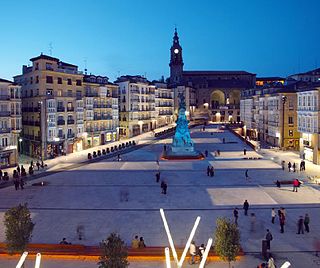
Vitoria-Gasteiz is the seat of government and the capital city of the Basque Country and of the province of Araba/Álava in northern Spain. It holds the autonomous community's House of Parliament, the headquarters of the Government, and the Lehendakari's official residency. The municipality—which comprises not only the city but also the mainly agricultural lands of 63 villages around—is the largest in the Basque Country, with a total area of 276.81 square kilometres (106.88 sq mi), and it has a population of 252,571. The dwellers of Vitoria-Gasteiz are called vitorianos or gasteiztarrak, while traditionally they are dubbed babazorros.

Palencia is a city of Spain located in the autonomous community of Castile and León. It is the capital and most populated municipality of the province of Palencia.

Vitória, spelled Victória until the 1940s, is the capital of the state of Espírito Santo, Brazil. It is located on a small island within a bay where a number of rivers meet the sea. It was founded in 1551. The city proper 93 square kilometres has a population of 358,875 (2015) whilst the Greater Vitória metropolitan area has a population of more than 1,857,616 (2013), the 14th largest in Brazil.
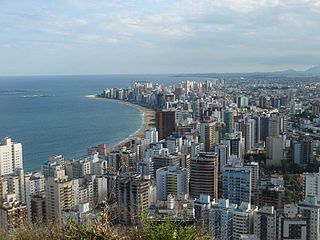
Vila Velha is a coastal city in Espírito Santo, Brazil. It lies across from Vitória, the state capital. Its population was 486,208 (2018) and its area is 208.82 km².

Duque de Caxias is a city on Guanabara Bay and part of Rio de Janeiro metropolitan area, being the third most populous in Rio de Janeiro state, southeastern Brazil.

Agurain in Basque and Salvatierra in Spanish, it is a town and municipality located in the province of Álava in the Basque Autonomous Community, northern Spain. The municipality, numbering 4,986 inhabitants (2015), is in turn the head town of the district or Cuadrilla of Salvatierra. The gross income per family amounts to 6,784 €. With reference to workforce by economic sectors, 10.36% are employed in agriculture, 35.78% in the industry sector, 47.92% in the service sector and 5.95% in the construction industry.

Canoas, which earned city status in 1939, is a municipality in the Brazilian state of Rio Grande do Sul. With more than 340,000 inhabitants, it is part of the Porto Alegre conurbation and has the second highest GDP in the state. It is also the fourth largest city in the state by population. Canoas boasts a strong manufacturing-based economy and is the home of the Canoas Air Force Base, used by the Brazilian Air Force.

Mooca from tupi mo-oka, meaning to build houses, is a district in the subprefecture of the same name in the city of São Paulo, Brazil. Mooca today is home to over 75,000 inhabitants, spread in its 7.7 square kilometres (3.0 sq mi). It is also considered one of the fastest growing districts in the city, experiencing over the last years a vigorous momentum in the construction industry. Mooca has been the stage for many social movements, specially because of the presence of a strong influence of the industry interests in the political scene of São Paulo towards the end of the 19th century and the beginning of the 20th century. The composition of Mooca's economy today ranges from small businesses ran by locals, large industries, such as Lorenzetti and Groupe SEB, both important players locally and globally in the home appliances industry, and ultimately, large shopping malls offering a variety of services.
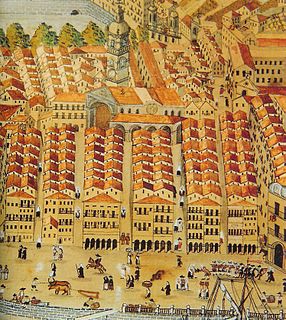
Las Siete Calles or Casco Viejo in Spanish or Zazpikaleak or Alde Zaharra in Basque are different names for the medieval neighbourhood of Bilbao, part of the Ibaiondo district. The names mean Seven Streets or Old Town respectively and it used to be the walled part of the town until the end of the 19th century.

Burgos Airport (IATA: RGS, ICAO: LEBG), also known as Villafría, is an airport located 4 kilometres (2.5 mi) east of the historic center of Burgos, a city in Spain. The company Aeronova has its maintenance headquarters in Villafría.
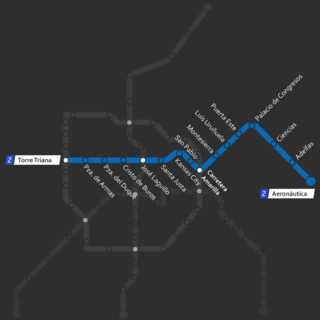
The Line 2 of the Metro of Seville will span the city from east to west, connecting the neighbourhoods of La Cartuja and Torreblanca.
Fifteen years ago, the old bus station of Vitoria-Gasteiz, Spain was demolished. Then some years later, Artium Museum was built in the place where the old bus station had been built. After demolishing the old bus station, a new one was built in Los Herran street. However, the current bus station in Vitoria, the one in Los Herran street, is just working temporarily, because in May 2011 the construction of the new bus station was going to begin. Some months prior, the town hall organized a competition in which the participants, taking in account some requirements, were asked to design an intermodal bus station in Vitoria. Eight companies presented their jobs, and the town hall decided that the project designed by Fernando Ruiz de Ocenda, Iñaki Usandizaga and Francisco Javier Garcia de Acilu was the most appropriate.

Abechuco is a village in the municipality of Vitoria in Álava, Basque Country, Spain. It is located on the outskirts of Vitoria.
Arriaga-Lakua was a Spanish village in Álava, Basque Country and is at present one quarter of Vitoria-Gasteiz.

The Abetxuko Bridge is a steel girder bridge with organic forms in Vitoria-Gasteiz, Álava, Basque Country, Spain.
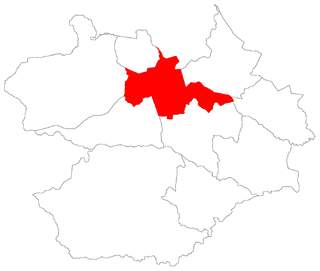
Sede ("Seat") is a district of the municipality of Santa Maria, in the Brazilian state of Rio Grande do Sul. It is situated in the north portion of Santa Maria. Downtown Santa Maria is one of its bairros (neighbourhoods).
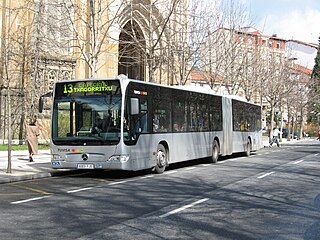
Tuvisa is the municipal company responsible for urban transport in the city of Vitoria-Gasteiz, in the north of Spain. The company has 79 grey buses, the majority of which are Mercedes-Benz and MAN.
The Copa dos Campeões Estaduais, the "Cup of State Champions," was a competition for Brazilian association football clubs held in the years 1920 and 1936. In the absence of other notable national competitions, the winners considered themselves champions of Brazil. Participants were the champions of the states considered the then leading forces in Brazilian football.